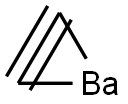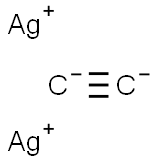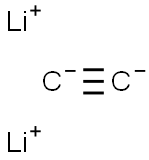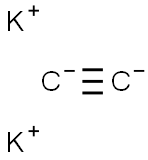SODIUM ACETYLIDE
Synonym(s):Ethynyl sodium
- CAS NO.:1066-26-8
- Empirical Formula: C2HNa
- Molecular Weight: 48.02
- MDL number: MFCD00008568
- EINECS: 213-908-9
- SAFETY DATA SHEET (SDS)
- Update Date: 2025-01-27 09:38:02

What is SODIUM ACETYLIDE?
Description
Sodium acetylide is an unstable powder, a salt of acetylene. It is a severe explosion risk when shocked or heated. It is used in the manufacture of detonators.
Chemical properties
brown slurry
The Uses of SODIUM ACETYLIDE
Sodium acetylide suspension has been used in the preparation of: 2-ethynyladamantan-2-ol1 apical-equatorial (ae) isomer of (Et4N)3[1-(2′-B10H9)-2-NH3B10H8]2 trimethylsilylacetylene3
The Uses of SODIUM ACETYLIDE
Sodium Acetylide Suspension is a reagent used in the synthesis of rhodium(I) amidinate complexes.
Definition
ChEBI: The salt formed from the acetylide monoanion and a single sodium cation.
Preparation
Sodium acetylide is a prepared from acetylene by deprotonation using a sodium base, typically sodium amide.
HC≡CH + NaNH2 → NaC≡CH + NH3
Purification Methods
It sometimes contains diluents, e.g. xylene, butyl ether or dioxane which can be removed by filtration followed by a vacuum at 65-60o/5mm. Alternatively the acetylide is purged with HCCH at 100-125o to remove diluent. NaC2H adsorbs 2.2x, 2.0x and 1.6x its wt of xylene, butyl ether and dioxane, respectively. Powdered NaC2H is yellow or yellow-gray in colour and is relatively stable. It can be heated to ca 300o in the absence of air. Although no explosion or evolution of gas occurs, it turns brown due to disproportionation. At 170-190o in air it ignites slowly and burns smoothly. At 215-235o in air it “flash-ignites” and burns quickly. It can be dropped into a slight excess of H2O without flashing or burning, but vigorous evolution of HC CH (HIGHLY FLAMMABLE IN AIR) occurs. The sample had been stored in the absence of air for one year without deterioration. Due to the high flammability of HCCH, the salt should be stored dry and should be treated with care. After long storage, NaCCH can be redissolved in liquid NH3 and used for the same purposes as the fresh material. However it may be slightly turbid due to the presence of moisture. [Rutledge J Org Chem 22 649 1957, Greenlee & Henne J Am Chem Soc 77 5013 1955, Campbell & Campbell Inorg Synth II 76, 81 1946, Org Synth 30 15 1950, Beilstein 1 H 238.] It is available commercially under N2 in Sure/Seal bottles as an 18 wt% solution in xylene/mineral oil. See “Aliphatic Compounds”, Chapter 4, for its prepartion.
Properties of SODIUM ACETYLIDE
| Boiling point: | -22.2°C |
| Density | 0,865 g/cm3 |
| Flash point: | 85 °F |
| storage temp. | Refrigerator (+4°C) + Flammables area |
| form | Low Melting Solid or Crystalline Powder |
| color | White to pale yellow |
| Water Solubility | Reacts with water. |
| Sensitive | Air & Moisture Sensitive |
| BRN | 3587232 |
| CAS DataBase Reference | 1066-26-8(CAS DataBase Reference) |
| EPA Substance Registry System | Sodium acetylide (1066-26-8) |
Safety information for SODIUM ACETYLIDE
| Signal word | Danger |
| Pictogram(s) |
 Flame Flammables GHS02  Corrosion Corrosives GHS05  Exclamation Mark Irritant GHS07  Health Hazard GHS08 |
| GHS Hazard Statements |
H226:Flammable liquids H261:Substances And Mixtures Which, In Contact With Water,Emit Flammable Gases H304:Aspiration hazard H314:Skin corrosion/irritation H335:Specific target organ toxicity, single exposure;Respiratory tract irritation H373:Specific target organ toxicity, repeated exposure H412:Hazardous to the aquatic environment, long-term hazard |
| Precautionary Statement Codes |
P210:Keep away from heat/sparks/open flames/hot surfaces. — No smoking. P280:Wear protective gloves/protective clothing/eye protection/face protection. P231+P232:Handle under inert gas. Protect from moisture. P301+P330+P331:IF SWALLOWED: Rinse mouth. Do NOT induce vomiting. P303+P361+P353:IF ON SKIN (or hair): Remove/Take off Immediately all contaminated clothing. Rinse SKIN with water/shower. P305+P351+P338:IF IN EYES: Rinse cautiously with water for several minutes. Remove contact lenses, if present and easy to do. Continuerinsing. |
Computed Descriptors for SODIUM ACETYLIDE
New Products
Indole Methyl Resin tert-butyl 9-methoxy-3-azaspiro[5.5]undecane-3-carboxylate Boc-His(Boc)-OH 2-CTC Resin 4-Chloro-7-tosy1-7Hpyrrolo[2,3-d]pyrimidine 5,7-Dibromo-1H-indole 2,5-dichloro-N-hydroxy-4,6-dimethylpyridine-3-carboximidamide 2,2-Dimethoxy-7-azaspiro[3.5]nonane hydrochloride 4-chloromethyl-5-methyl-1,3-dioxol-2-one (DMDO-Cl) R-2-BENZYLOXY PROPIONIC ACID 1,1’-CARBONYLDIIMIDAZOLE 1,1’-CARBONYLDI (1,2-4 TRIAZOLE) N-METHYL INDAZOLE-3-CARBOXYLIC ACID 4-((2-hydroxyethyl)thio)benzoic acid 1-(TERT-BUTOXYCARBONYL)-2-PYRROLIDINONE Methyl 6-methylnicotinate 3-Pyridineacrylic acid tert-Butyl carbazate TETRAHYDRO-2H-PYRAN-3-OL 2-((4-morpholinophenylamino) (methylthio) methylene) malononitrile 3-(4-morpholinophenylamino)-5-amino-1H-pyrazole-4-carbonitrile 2,4-dihydroxybenzaldehyde 1,3-Diethyl-1,3-Diphenylurea Methyl 2-methylquinoline-6-carboxylateRelated products of tetrahydrofuran








You may like
-
 Sodium acetylide suspension CAS 1066-26-8View Details
Sodium acetylide suspension CAS 1066-26-8View Details
1066-26-8 -
 Pyridine 99.5% HPLC /UV SpectroscopyView Details
Pyridine 99.5% HPLC /UV SpectroscopyView Details
110-86-1 -
 Guanine , 99%View Details
Guanine , 99%View Details
73-40-5 -
 Piperazine Spot supply, best priceView Details
Piperazine Spot supply, best priceView Details
110-85-0 -
 Dibutyl PhthalateView Details
Dibutyl PhthalateView Details
84-74-2 -
 Imidazole Spot supply, competitive priceView Details
Imidazole Spot supply, competitive priceView Details
288-32-4 -
 Octadecyl 3-(3,5-di-tert-butyl-4-hydroxyphenyl)propionate 98% (GC)View Details
Octadecyl 3-(3,5-di-tert-butyl-4-hydroxyphenyl)propionate 98% (GC)View Details
2082-79-3 -
 Thiourea 99% ARView Details
Thiourea 99% ARView Details
62-56-6
